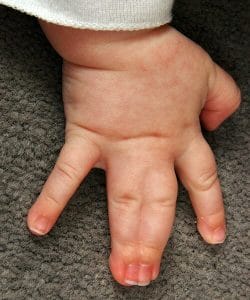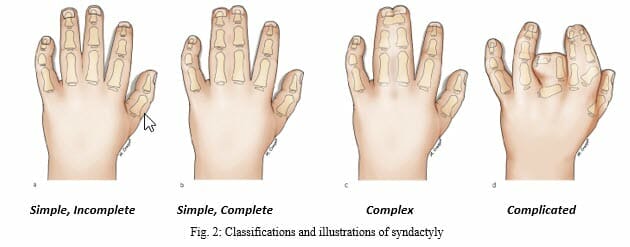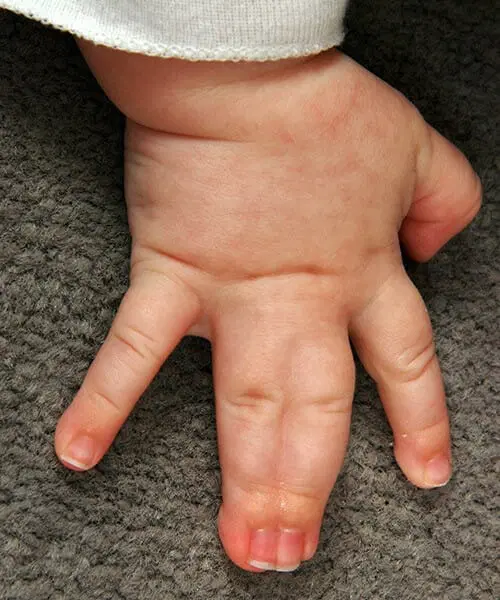Syndactyly is a congenital condition where two or more fingers are joined together, either by skin, soft tissue, or bone. At Tran Plastic Surgery, we specialize in advanced surgical treatments to restore both function and appearance to the hand. Located in Huntington Beach, CA, our practice provides expert care under the direction of Dr. Tuan Tran, a board-certified hand and plastic surgeon with extensive experience in congenital hand reconstruction.
What is Syndactyly?
Syndactyly is one of the most common congenital hand differences, occurring in approximately 1 out of every 2,500 newborns. While it may affect either the hands or feet, syndactyly most often involves the fingers. This condition can range from a simple connection of skin between digits to a more complex fusion involving bone and cartilage.
Because the hand is essential for grasping, fine motor skills, and daily function, syndactyly can limit mobility and, in some cases, affect a child’s self-esteem as they grow. Fortunately, surgical treatment allows children to regain independence, comfort, and confidence.
For additional information on related hand conditions, visit our Hand Surgery services page.
Classifications of Syndactyly
Not all cases of syndactyly are the same. Understanding the classifications helps determine the appropriate treatment plan:
-
Incomplete Syndactyly – The fusion does not extend to the fingertips.
-
Complete Syndactyly – The digits are joined all the way to the fingertips.
-
Simple Syndactyly – The fingers are connected only by soft tissue.
-
Complex Syndactyly – The fingers are joined by both soft tissue and bone/cartilage.
-
Complicated Syndactyly – The condition is associated with extra or missing bones, abnormal digit shapes, or part of a genetic syndrome.
Each classification presents unique surgical challenges, and treatment is customized to the child’s needs.
 Fig. 1: Complete syndactyly of the 3rd and 4th digit in a 1-year old child.
Fig. 1: Complete syndactyly of the 3rd and 4th digit in a 1-year old child.
What Causes Syndactyly?
The exact cause of syndactyly is not always known. During early fetal development, all fingers are initially webbed. Normally, the fingers separate by the end of the eighth week of gestation. When this natural process is disrupted, the fingers remain fused.
Key contributing factors include:
-
Genetics: About 10–40% of cases are inherited.
-
Syndromic Associations: Syndactyly can be part of conditions such as Apert syndrome, Poland syndrome, or Holt-Oram syndrome.
-
Sporadic Occurrence: In many children, syndactyly appears without family history or related conditions.
Importantly, parents cannot prevent syndactyly—it develops naturally during gestation and is not caused by anything done during pregnancy.
Symptoms and Functional Impact
The effect of syndactyly depends on the number of fingers involved and the severity of the fusion. Common challenges include:
-
Reduced Hand Function: Difficulty spreading the fingers can make it harder to grasp large or round objects.
-
Growth Issues: Complex or complete syndactyly can interfere with proper growth of the affected digits.
-
Aesthetic Concerns: Visible differences may cause stress, social discomfort, or decreased self-esteem for children.
Even when function is relatively normal, parents often choose treatment to improve both function and appearance.

 Fig.3: Syndactyly release surgery with z-plasty technique.
Fig.3: Syndactyly release surgery with z-plasty technique.
Diagnosis and Doctor Evaluation
Syndactyly is usually obvious at birth. In some cases, it may even be detected on a prenatal ultrasound.
During evaluation at Tran Plastic Surgery, your child will undergo:
-
Physical Examination: Assessing the extent of webbing and hand movement.
-
X-rays: To evaluate whether bones and joints are also fused.
-
Growth Monitoring: Ensuring that the condition does not worsen as the child develops.
A thorough examination allows Dr. Tuan Tran to develop a personalized treatment plan.
Treatment: Syndactyly Surgery
The only definitive treatment for syndactyly is surgery. At Tran Plastic Surgery, we use precise reconstructive techniques to safely separate the digits and restore mobility.
Timing of Surgery
Surgery is typically performed between 12 to 24 months of age, when the hand is developed enough for reconstruction but before growth and motor development are significantly affected. Early intervention helps ensure the best long-term function.
Surgical Technique
The most common method is Z-plasty, a technique that uses zig-zag incisions to evenly distribute skin and prevent scarring. In some cases, additional skin grafts may be required, often taken from another part of the body, to provide adequate coverage between the separated digits.
Because of blood supply and skin availability, fingers are often separated in stages—usually two at a time if multiple digits are affected.
Post-Surgical Care
Recovery is just as important as surgery itself:
-
Casting: After surgery, the hand is placed in an above-elbow cast for approximately three weeks.
-
Splinting: Once the cast is removed, a splint may be used to keep fingers apart for another six weeks.
-
Hand Therapy: Guided therapy is recommended to prevent stiffness, reduce swelling, and improve range of motion.
Our team provides ongoing support to ensure your child’s healing and adaptation process is successful.
Outcomes and Long-Term Prognosis
Most children achieve excellent outcomes following syndactyly surgery. Benefits include:
-
Improved finger separation and mobility
-
Enhanced ability to grasp and manipulate objects
-
Better symmetry and hand appearance
-
Increased self-confidence and social comfort
Ongoing follow-ups may be needed to monitor growth. In some cases, additional surgery can refine results as the child grows.
Why Choose Tran Plastic Surgery?
Choosing the right surgeon is critical for your child’s future hand function. At Tran Plastic Surgery, families trust us for:
-
Expertise in Hand Surgery: Dr. Tran is a board-certified plastic surgeon with fellowship training in hand and microsurgery.
-
Personalized Care: Each treatment plan is tailored to your child’s condition and needs.
-
Advanced Techniques: We use the latest reconstructive methods to ensure both safety and cosmetic results.
-
Family-Centered Approach: We provide guidance, education, and reassurance throughout every step.
For related procedures, learn more about conditions like Thumb Ulnar Collateral Ligament Tear or aesthetic improvements such as a Surgical Handlift.
Schedule a Consultation
At Tran Plastic Surgery, we understand the importance of your child’s hand development and quality of life. If your child has been diagnosed with syndactyly, we encourage you to schedule a consultation with Dr. Tuan Tran to discuss treatment options.
📞 Call us at 714-839-8000 or contact us online to book your appointment today.
*References:
✍️ Boston Children’s Hospital. (2020). Conditions: Syndactyly. Retrieved from http://www.childrenshospital.org/conditions-and-treatments/conditions/s/syndactyly
✍️ Boston Children’s Hospital. (2020). Syndactyly: Diagnosis & treatment. Retrieved from http://www.childrenshospital.org/conditions-and-treatments/conditions/s/syndactyly/diagnosis-and-treatment#:~:text=How%20is%20syndactyly%20diagnosed%3F,determine%20a%20course%20of%20treatment.
✍️ Kvemmo, H. (2013). Figure 3: Treatment of congenital syndactyly of the fingers. Retrieved from https://www.researchgate.net/figure/Example-of-a-plasty-for-separation-of-syndactyly-between-the-long-and-ring-finger-a_fig3_256083902
✍️ Kyemmo, H. (2013). Figure 3: Treatment of congenital syndactyly of the fingers. Retrieved from https://www.researchgate.net/figure/Classification-of-syndactyly-Syndactyly-between-long-and-ring-finger-a-Simple_fig2_256083902/actions#reference
✍️ Washington University Physicians. (2017). Syndactyly. Retrieved from https://www.ortho.wustl.edu/content/Patient-Care/3221/Services/Hand-Microsurgery/Overview/Congenital-Hand-Disorders/Syndactyly.aspx

